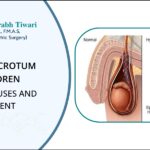Pediatric surgery for congenital heart defects is a specialized field dedicated to addressing and correcting heart conditions that are present at birth. Congenital heart defects (CHDs) are the most common type of birth defect, affecting nearly 1% of all births globally. Advances in pediatric cardiology and cardiac surgery have dramatically increased survival rates and quality of life for children with CHDs.
Understanding Congenital Heart Defects
Congenital heart defects are structural anomalies in the heart that occur while a baby is developing in the womb. These defects can affect the heart’s chambers, valves, and blood vessels, leading to impaired blood flow and, in severe cases, life-threatening complications. CHDs range from simple conditions, such as small holes in the heart, to complex structural issues that require urgent intervention.
Must Read – What is Pediatric Gastrointestinal Surgery?
Types of Congenital Heart Defects
There are numerous types of CHDs, each with unique characteristics and challenges. Some of the most common congenital heart defects include:
- Atrial Septal Defect (ASD): A hole in the wall (septum) that divides the heart’s upper chambers (atria). This defect allows oxygen-rich blood to mix with oxygen-poor blood, reducing the heart’s efficiency.
- Ventricular Septal Defect (VSD): A hole in the septum separating the lower chambers (ventricles) of the heart. This defect can lead to increased blood flow to the lungs and overwork the heart.
- Tetralogy of Fallot (TOF): A combination of four defects, including VSD, pulmonary stenosis, right ventricular hypertrophy, and an overriding aorta, which together cause oxygen-poor blood to circulate in the body.
- Coarctation of the Aorta: A narrowing of the aorta that restricts blood flow to the lower part of the body, causing high blood pressure and heart damage over time.
- Transposition of the Great Arteries (TGA): A defect in which the main arteries carrying blood from the heart are reversed, resulting in improper blood circulation.
Diagnosing Congenital Heart Defects
Timely diagnosis of congenital heart defects is essential to ensure effective treatment and improved survival rates. Pediatric cardiologists employ a range of diagnostic tools to detect and assess the severity of CHDs.
Common Diagnostic Techniques
- Fetal Echocardiography: A specialized ultrasound performed during pregnancy to identify heart defects in the fetus. This technique enables early diagnosis and preparation for surgical intervention if necessary.
- Echocardiogram: This imaging technique uses sound waves to create detailed images of the heart, helping doctors visualize structural abnormalities.
- Electrocardiogram (ECG or EKG): This test records the heart’s electrical activity and helps identify irregular heart rhythms associated with CHDs.
- Chest X-ray: Often used to evaluate heart size and the presence of any lung congestion caused by heart defects.
- Cardiac MRI and CT Scans: Advanced imaging techniques that provide a comprehensive view of the heart and surrounding blood vessels.
- Cardiac Catheterization: A minimally invasive procedure in which a catheter is inserted into a blood vessel and guided to the heart to measure pressure and oxygen levels and to detect any abnormalities.
Surgical Options for Treating Congenital Heart Defects
The complexity and severity of a congenital heart defect determine the appropriate surgical approach. Pediatric cardiac surgery ranges from minimally invasive procedures to complex open-heart surgeries.
Types of Pediatric Heart Surgeries
- Septal Defect Repairs (ASD and VSD): These surgeries close holes in the heart’s septum. Surgeons use patches or sutures to close the defect, restoring normal blood flow.
- Tetralogy of Fallot Repair: TOF repair requires closing the VSD and widening the pulmonary artery to improve oxygen levels in the blood. This complex surgery is often performed within the first year of life.
- Arterial Switch Operation for TGA: In this procedure, surgeons reconnect the aorta and pulmonary artery to their correct positions, ensuring proper blood flow and oxygenation.
- Norwood Procedure for Hypoplastic Left Heart Syndrome (HLHS): This three-stage surgical process is necessary to reconstruct the heart and improve blood flow in children with underdeveloped left heart chambers.
- Valve Repair or Replacement: For cases involving defective heart valves, surgeons may repair or replace the valve to enhance blood flow through the heart.
- Coarctation Repair: This surgery involves removing or widening the narrowed portion of the aorta to relieve pressure and allow for proper blood flow.
Minimally Invasive Techniques in Pediatric Cardiac Surgery
Technological advancements have led to the development of minimally invasive techniques, reducing recovery times and minimizing the risks associated with traditional open-heart surgery. Common minimally invasive techniques include:
- Cardiac Catheterization: This method is used to repair simple defects, such as closing small holes, with the use of a catheter inserted into a blood vessel.
- Balloon Angioplasty: In this procedure, a catheter with an inflatable balloon is used to widen narrowed arteries, such as in cases of coarctation.
- Stent Placement: Stents are small mesh tubes placed in arteries to keep them open and improve blood flow. This approach is beneficial for children with narrowed arteries or veins.
These minimally invasive techniques reduce surgical risks and recovery times, allowing children to return to their normal activities sooner.
Post-Operative Care and Recovery
Post-operative care is critical for children undergoing heart surgery. Recovery may vary depending on the type and complexity of the procedure. Pediatric heart surgery patients often require a combination of hospital care, home monitoring, and follow-up appointments with their cardiologist.
Hospital Care and Monitoring
- Intensive Care Unit (ICU): After surgery, children are typically monitored in the ICU to ensure stability. Vital signs, oxygen levels, and heart function are closely observed.
- Pain Management: Pain control is essential for comfort and healing, often managed through a combination of medications.
- Respiratory Therapy: Breathing exercises and support may be required to help young patients regain strength and maintain oxygen levels.
- Nutritional Support: A balanced diet supports healing, and in some cases, tube feeding may be necessary if the child has difficulty eating.
Recent Advances in Pediatric Heart Surgery
Pediatric heart surgery has evolved significantly, with advancements improving outcomes and reducing risks. Some notable developments include:
- 3D Printing for Surgical Planning: Surgeons can create 3D models of a child’s heart to better plan complex surgeries, enhancing precision and safety.
- Robotic-Assisted Surgery: Robotics allows for highly precise, minimally invasive surgeries, reducing trauma to the body and shortening recovery times.
- Hybrid Procedures: Hybrid procedures combine traditional surgery with catheter-based techniques, offering more options for managing complex congenital heart defects.
Pediatric surgery for congenital heart defects plays a crucial role in giving children born with heart anomalies the chance for a healthy life. Consult Dr. Saurabh Tiwari, a renowned pediatric surgeon in Goregaon, Malad, Andheri, and Jogeshwari, is dedicated to providing exceptional care for children.




